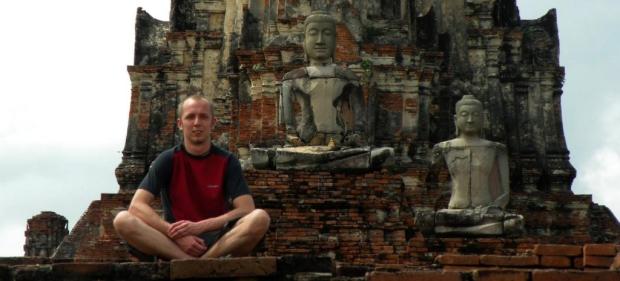In the last travel post I started to describe what we saw in Ayutthaya concentrating mainly on the city Island. I would like to continue doing so and at the end describe Wat Chaiwatthanaram and Phra Mongkonbophit.
Wat Ratchaburana (วัดราชบุรณะ) is also called the Monastery of the Royal Repairs or the Monastery of the Royal Restoration.
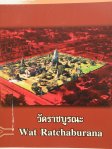 Not much is known on the history of this temple in the period between its establishment in 1424 and its destruction in 1767. The most significant feature is the nearly 600 year old chedi said to enshrine relics of the Buddha. However, there is no access to the chedi’s spire. On ayutthaya-history.com you can see some pictures from inside the temple. I love the one showing the ceiling and this is why I enclose it here. I did not go in to the temple of any of the surrounding buildings in which a showroom displaying old coins, bank notes, musical instruments and glass objects is available.
Not much is known on the history of this temple in the period between its establishment in 1424 and its destruction in 1767. The most significant feature is the nearly 600 year old chedi said to enshrine relics of the Buddha. However, there is no access to the chedi’s spire. On ayutthaya-history.com you can see some pictures from inside the temple. I love the one showing the ceiling and this is why I enclose it here. I did not go in to the temple of any of the surrounding buildings in which a showroom displaying old coins, bank notes, musical instruments and glass objects is available.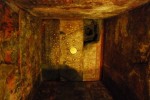 There is a fee of 50 Baht (1.63 USD) to enter the grounds of Wat Ratchaburana. The temple is open from 8:30 am to 5:00 pm every day.
There is a fee of 50 Baht (1.63 USD) to enter the grounds of Wat Ratchaburana. The temple is open from 8:30 am to 5:00 pm every day.
In september of 1957 A.D. looters dug into a two-level crypt inside the main prang (Khmer-type tower) and stole a great quantity of valuable material. Police arrested some of these looters. The Fine Arts Department proceeded to excavate the site and found Buddha images and many artifacts made of gold. Among these were a large number of votive tablets made of gold and lead. 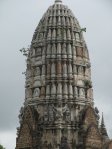 Staff of the Thai Fine Arts Department conducted a further excavation and discovered that there were the vault had three stories. Confiscated artifacts amounted to 2,000 items. Among them were more than 100,000 votive tablets and more than 100 kilograms of gold jewelry. Since the Buddha images were very numerous the ministers approved giving some of them to people who had contributed to the building of the Chao Sam Phraya National Museum.
Staff of the Thai Fine Arts Department conducted a further excavation and discovered that there were the vault had three stories. Confiscated artifacts amounted to 2,000 items. Among them were more than 100,000 votive tablets and more than 100 kilograms of gold jewelry. Since the Buddha images were very numerous the ministers approved giving some of them to people who had contributed to the building of the Chao Sam Phraya National Museum.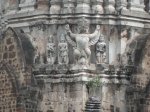
Wat Rachabutana has three porticos facing east, north and south. The ruins of various satellite chedi and the walls of viharns surround it. There is a two-level crypt inside the main prang, and visitors are able to go down the steps to view the fine 15th century mural paintings that are preserved there. The lower level murals are of Chinese influence, while the upper level depict stories of Buddhism and Buddha’s lives. Flanking the base of the Chedi are stucco images of Yaksha demons and animals of the Himavana mythical forest.
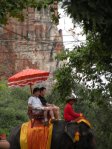 Three more sights I think are worth visiting (even though I haven’t seen them) are Wat Yai Chai – mongkol, Wat Phanan Choeng and Wat Naphrameru.
Three more sights I think are worth visiting (even though I haven’t seen them) are Wat Yai Chai – mongkol, Wat Phanan Choeng and Wat Naphrameru.
There is also an elephant camp just opposite Khum Khun Phaen offering elephant rides as well as daily shows and feeding from 9:00 to 17:00. You are seated comfortably high up on a cushioned howdah and travel in royal style. Just to warn you the ride is far more expensive than the one in Chiang Mai. Also in Chiang Mai the elephants will track through the jungle while the ones here just walk along the street.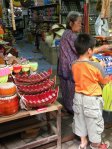
Next to all the monuments is a wonderful market full of colorful wares and food. Enjoy the pictures in the slideshow at the bottom of the post.
Phra Mongkonbophit (Buddha of the Holy and Supremely Auspicious Reverence) is a sanctuary housing the large bronze Phra Mongkhon Bophit Budha image. It was previously damaged by lightening and then restored in the Rama V period.
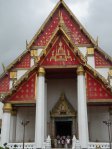 And the last but not least Wat Chaiwatthanaram (วัดไชยวัฒนาราม). It is one of the most beautiful ancient Buddhist monasteries. It is believed that it was located on the site of King Prasatthong former home. The reason for building it was to make merit for his mother.
And the last but not least Wat Chaiwatthanaram (วัดไชยวัฒนาราม). It is one of the most beautiful ancient Buddhist monasteries. It is believed that it was located on the site of King Prasatthong former home. The reason for building it was to make merit for his mother.
What does it mean to make merit you may ask. One of the most common religious practices among Thai Buddhists is merit making. Whether it is giving food to the monks on their daily alms round, bringing offerings to the temple, or chanting in the ancient language. 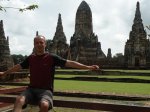 The majority of Buddhists who make merit are hoping to gain happiness in the present life but it is also believed that this merit will have good effects on your next life. Another reason to make merit is to help you see the truth about life, namely that life is always changing and never certain, that there is birth and death, there is meeting and parting, and material objects are impermanent. It helps to reduce desires and cease attachment to worldly things.
The majority of Buddhists who make merit are hoping to gain happiness in the present life but it is also believed that this merit will have good effects on your next life. Another reason to make merit is to help you see the truth about life, namely that life is always changing and never certain, that there is birth and death, there is meeting and parting, and material objects are impermanent. It helps to reduce desires and cease attachment to worldly things.
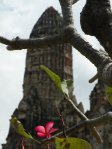 This Wat consists of main prang (Khmer – type tower) and four lesser prangs, all built on the same baseand surrounded by eight lesser prangs and a gallery. Along the gallery were placed 120 gilt lacquered buddha images in the attitude of maravijaya or Victory over Mara, the Evil One. Within the eight lesser prangs there are twelve crowned Buddha images. The ceiling of each alcove was made of wood and was decorated with gilded star-like patterns on black lacquer. Walls inside have mural paintings while the outside walls were adorned with twelve stucco relief decipting stories from the life of Buddha.
This Wat consists of main prang (Khmer – type tower) and four lesser prangs, all built on the same baseand surrounded by eight lesser prangs and a gallery. Along the gallery were placed 120 gilt lacquered buddha images in the attitude of maravijaya or Victory over Mara, the Evil One. Within the eight lesser prangs there are twelve crowned Buddha images. The ceiling of each alcove was made of wood and was decorated with gilded star-like patterns on black lacquer. Walls inside have mural paintings while the outside walls were adorned with twelve stucco relief decipting stories from the life of Buddha.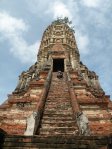
The main prang is 35 meters high and was built in early Ayutthaya style. The four lesser prangs on the other hand are in the style of King Prasattong. They have seven levels. We climbed one of them. The stairs are very steep, the higher the worse.
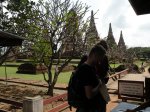 At the entrance to the monastery we had our pictures taken and then were able to purchase a plate with it. Mine is right now at my grandparents place so I can’t show you the picture. let me just say I never regretted buying it. A nice souvenir. I really wish we had more time to sightsee Ayutthaya. Don’t go on a one day tour offered in Bangkok it will not be ebough as you spend only 3-4 hours at the sight. It’s worth 2 days. Other attractions include cycling, boat cruises along the river and kayaking in the canals. you won’t be bored.
At the entrance to the monastery we had our pictures taken and then were able to purchase a plate with it. Mine is right now at my grandparents place so I can’t show you the picture. let me just say I never regretted buying it. A nice souvenir. I really wish we had more time to sightsee Ayutthaya. Don’t go on a one day tour offered in Bangkok it will not be ebough as you spend only 3-4 hours at the sight. It’s worth 2 days. Other attractions include cycling, boat cruises along the river and kayaking in the canals. you won’t be bored.
